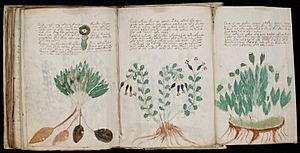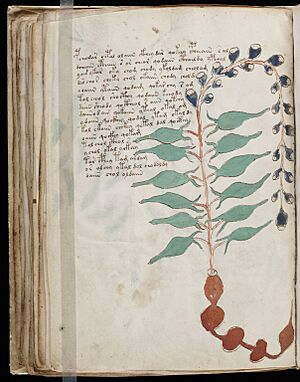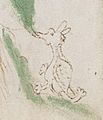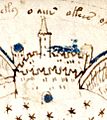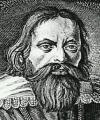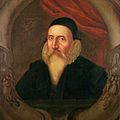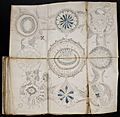Voynich manuscript facts for kids
The Voynich manuscript is a very old and mysterious book. It's named after Wilfrid Michael Voynich, who bought it a long time ago in the early 1900s. This special book has about 240 pages made from vellum, which is a type of animal skin used for writing on. Experts believe it was probably written in the early 1400s in northern Italy. Today, you can find it at Yale University's library.
Many pages in the manuscript have interesting illustrations. Even though many people have tried to figure out who wrote it, the author is still a secret! The words are written in a language and a writing style that no one understands. What's even stranger is that the text looks perfect, with no mistakes or corrections. People think it might be a secret code or a cipher. Many experts who work with codes, both pros and hobbyists, have tried to crack it. The pictures, which show plants, body parts, or even stars, haven't gotten as much attention. This book is often called "the world's most mysterious manuscript."
In 2009, scientists from the University of Arizona used a method called radiocarbon dating on the vellum pages. They found that the vellum was made between 1404 and 1438. Also, the McCrone Research Institute in Chicago discovered that most of the ink was added soon after the vellum was made. This proves that the Voynich manuscript is a real book from the Middle Ages.
Contents
What's Inside the Voynich Manuscript?
Since no one has been able to read the Voynich manuscript yet, people have divided it into different parts based on the pictures. Here's how it's usually organized:
- Plant Section (Herbal): Each page shows one or two plants with some writing next to them.
- Star Section (Astronomical): This part has pictures that look like symbols for stars or astronomy from that time, including the signs of the zodiac.
- Body Section (Biological): Here you'll see pictures of women bathing in pools. Some women wear crowns, and there are also drawings of body organs.
- Universe Section (Cosmological): This section has more round drawings, some of which even fold out! One big fold-out page shows six parts that look like connected islands with a volcano.
- Medicine Section (Pharmaceutical): This part has labeled pictures of plant pieces, along with jars that might have been used for medicines.
- Recipe Section: These are short bits of text, usually starting with a star or a flower drawing.
The very last page of the book seems to have a kind of "key." It's three lines of text that look like writing from 15th-century Germany.
What Was the Book For?
People have many ideas about why the Voynich manuscript was created.
Was It a Medical or Plant Book?
One main idea is that the book was a guide for making drugs or a book about medicine. The first big section is almost certainly a herbal. A herbal is a collection of plants with descriptions of what they are and what they do. However, it has been very hard to identify the plants based on the pictures alone. Only two plants have been guessed with some certainty: the Wild pansy and the Maidenhair fern. Many of the plant pictures seem to be made up of different parts from various plants. For example, the roots of one plant might be drawn with the leaves of another, and the flowers could be from a third type of plant. The leaves and fruit of the Castor oil plant have also been identified.
Could It Be About Alchemy?
Because of the strange tubes shown in the "biological" section, some people think the book might be about alchemy. Alchemy was an old practice that tried to turn common metals into gold or create special medicines. This idea would make sense if the book was about making certain kinds of medicine. But there's a problem with this theory: alchemy books from that time usually had specific types of pictures, and those pictures aren't found in the Voynich manuscript.
Is It About Astrology?
Another idea is that the book is about astrology. Astrology was very common back then, and practices like bloodletting (a medical treatment where blood was removed from a patient) were often linked to it. However, apart from the signs of the zodiac and one drawing that might show the classical planets, no one has been able to prove that the symbols in the Voynich manuscript are found in other astrology traditions.
Images for kids
-
Joannes Marcus Marci (1595–1667), who sent the manuscript to Athanasius Kircher in 1665 or 1666
-
Wilfrid Voynich (1865–1930) bought the manuscript in 1912
-
Edward Kelley (1555–97) might have created the manuscript as a trick
-
Mathematician John Dee (1527–1608) may have sold the manuscript to Emperor Rudolf around 1600.
See also
 In Spanish: Manuscrito Voynich para niños
In Spanish: Manuscrito Voynich para niños


